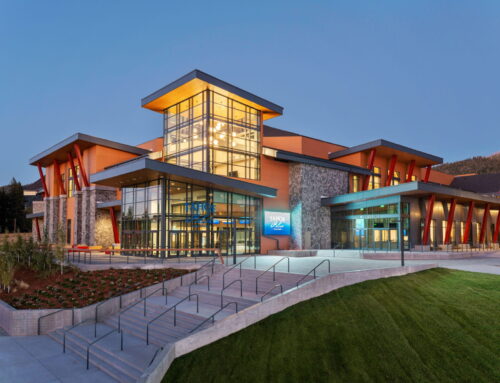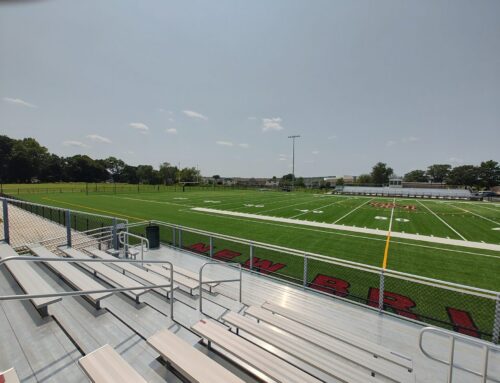InfoComm International feature
Metropolitan interactive, a digital, sustainable, marketing firm that employs designers, engineers, programmers, and construction personnel to create original solutions to technical challenges, has just celebrated a year of existence. In that span, Met interactive has managed to complete projects for the American Bible Society, BRIC Arts Media, Yale’s Loria Hall, The Warner Theater, The Museum of Biblical Arts, Brooklyn Academy of Music, Lincoln Center for the Performing Arts, and Central Synagogue in Manhattan. The projects included interactive displays, digital signage programs with IT infrastructure, digital cinema, and digital content strategies and marketing. We met with their CEO Jeffrey Mele to talk about professional development, integration, and innovation in the AV industry.
“I’ve been an InfoComm member for about 10 years, under various company names,” says Mele. “I think it’s helpful for us to be part of the technologic community that acts as a bridge between the users and the manufacturers and provides a forum for knowledge, collaboration, and education.”
Met interactive is also dedicated to the certification of their employees. “Slowly, people are becoming CTS certified and becoming members,” Mele says.
The company is a consolidation of the founders’ experience in system integration, software development, digital marketing, and sales. Jeff and Rachel Mele say that they put the company together to “solve technical challenges with human solutions.”
“As somebody who spent 20 years in systems integration and a fair amount of time in live production, once I got involved in software development, I started getting conditioned to think in a specific way,” Jeff says, adding that in software development the majority of time is spent in developing interaction architecture before a technical solution can be built. Information architecture is the process of applying an analysis of human behavior to a technological solution in order to find the best user experience.
Sometimes what you really need is a pencil
When Jeff was oscillating back and forth between the world of software development and the world of systems integration, he recognized a pattern on the integration side – people were too concerned with jumping to a piece of hardware or being enamored by the technology when they really needed to step back and look at the users’ operational behavior.
According to Jeff, most everything we do has some level of interaction whether it’s interaction with other people or interaction with environments. “There’s always a bidirectional interaction and that concept of interaction architecture.”
So, Jeff and Rachel brought those philosophies of development to the world of systems integration, particularly digital marketing and entertainment.
“By doing so, we sometimes find that, where we would’ve grabbed a screwdriver, we might grab a pencil. Sometimes, the technological choices that are made in the world of systems integration are too ingrained in the vertical in which you work,” says Jeff.
He continues, “We said, ‘Why should we have any barrier on technology?’ If we were an AV systems integrator, we shouldn’t limit ourselves to audiovisual equipment. We shouldn’t be limiting ourselves to network equipment if we were an IT firm. We should be able to expand our focus out from devices that fit neatly into these verticals and be able to look broad spectrum, pick the right tools no matter what it is or how obvious it may be. We take that philosophy and look at how we would approach a project differently.”
Met interactive has a client that had a large surface they wanted to cover with video – in part for marketing and to dress up the surface with video. They expressed their goals to their architect who requested a large canvas projection across the surface. The plan included large, edge blended projectors and a content playback system that would have functioned but would require an inordinate operational expense.
“By the time we got there,” Jeff says, “we looked at it and said simply, ‘What is your objective? What does this system offer to your operation and how will it serve you best?'”
They told Met interactive that they wanted to show compelling videos and be able to change the information daily. But that wouldn’t have worked with what the client already had. It would’ve taken days to prepare each content change. Met interactive backed up and looked first at the client’s operational goals and content strategy and then they redesigned the system. In doing so, they achieved what the client had wanted and helped them avoid a quarter of a million dollars in cost.
After a successful first year, Met interactive has many plans for further development.
The importance of investing in research
Their plan this year is to continue to expand their capabilities, particularly in manufacturing. They’re already working in product development. “We’ve found that the more you’re involved in product development the better adapted you are to deal with all the other products out there on the market because you have an innate understanding of what happens under the hood,” Jeff says.
“In addition, we’re looking to start structuring the company so that we can maintain our focus on practical innovation but also be able to segregate a segment of what we do to pure science, pure research.” According to Jeff, this is something that a lot of companies struggle with because, when it comes to finances, they will “veer toward the practical solutions and they will starve the research and development side.”
Jeff adds that Met interactive is finding new and creative ways to enable the pure research side and grow without being encumbered by necessities of business, finances, and the practical innovation.
Cloud security is a known quantity
Met interactive has been active in cloud-based solutions. All of the platforms that they’re developing for their clients are driven off cloud-based solutions distributed across many U.S. regions.
Touching on the issue of security in cloud-based AV solutions, Jeff says it’s something that will exist whether “you maintain an application entirely in house or in the cloud.”
According to Jeff, security risk is a result of having to harvest the Internet to use cloud-based solutions and that it won’t be going away.
“It’s a known quantity,” he adds. “But, you also have to weigh that against when you deploy a technical solution into a client’s environment, that security is only as good as their security administration.”
“You could provide the best solution possible but it only takes one very simple lapse in judgment for a client’s IT department to compromise your solution and the rest of their network,” according to Jeff.
Although there are several cloud security standards backed by international organizations that write and promote them, cloud security in AV depends on how well educated AV integrators are about the current trends in the integrative industries and, specifically, distributed computing.
“Even under the best of circumstances with the education in the AV industry, we still find that a lot of the engineers and technical personnel still lack some basic fundamental understanding of how data works in the IT realm,” Jeff explains. So, even though standards exist and most people would ask to tie an AV project to those standards, I think what you find is that are still practice issues that just needs to get better in this industry. And, it’s not entirely all related to security. It’s also related to the operational practice and to sustainability.”
A year ago, Met interactive purchased a firehouse built in 1884 in the heart of historic downtown Wallingford, CT, and transformed it into their headquarters. In their first year, they grew to sixteen employees who all work together to breed innovation through collaboration. They now also have an office in New York City. They are planning to have a booth at InfoComm 2015.
See the original article here.






